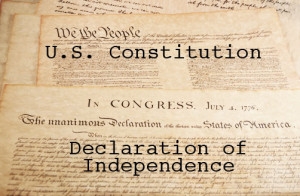December 13, 1952 – Transporting the Declaration of Independence and the Constitution, an armored Marine Corps personnel carrier made its way down Constitution Avenue, accompanied by two light tanks, four servicemen carrying sub-machine guns, and a motorcycle escort. A color guard, ceremonial troops, the Army Band, and the Air Force Drum and Bugle Corps were also part of the procession. Members of all the military branches lined the street. Inside the personnel carrier were six parchment documents. The records were in helium-filled glass cases packed inside wooden crates resting on mattresses. The Declaration of Independence and the Constitution were going to the National Archives. In 1926, $1 million was appropriated for a national archives building, and in 1930 President Hoover appointed an Advisory Committee for the National Archives to draw up specifications for the building. John Russell Pope was selected as architect, and a year later, ground was broken. By 1933, the cornerstone of the building had been put in place by President Herbert Hoover. Staff were working in the unfinished building by 1935. But despite this flurry of activity, the vault-like building did not house the founding documents that we call the “Charters of Freedom.” The documents had been shuttled around to various buildings for various reasons. They started out in the Department of State, and as the capital moved from New York to Philadelphia to Washington, DC, these documents moved too. Eventually they were turned over to the Library of Congress. With exception of a short stay at Fort Knox during World War II, the Declaration and the Constitution remained at the Library of Congress from 1921 to 1952. The Bill of Rights had been given into the safekeeping of the National Archives in 1938. In 1952, the Library of Congress agreed to transfer the Declaration and the Constitution to the National Archives. The Bill of Rights would finally be in the company of the two other founding documents. With great pomp and ceremony, the six boxes were carried up the steps. The tall bronze doors—now used only on July 4—were opened, and the six sheets of parchment were carried into the Rotunda, where they remain today.
December 13, 1952 – Transporting the Declaration of Independence and the Constitution, an armored Marine Corps personnel carrier made its way down Constitution Avenue, accompanied by two light tanks, four servicemen carrying sub-machine guns, and a motorcycle escort. A color guard, ceremonial troops, the Army Band, and the Air Force Drum and Bugle Corps were also part of the procession. Members of all the military branches lined the street. Inside the personnel carrier were six parchment documents. The records were in helium-filled glass cases packed inside wooden crates resting on mattresses. The Declaration of Independence and the Constitution were going to the National Archives. In 1926, $1 million was appropriated for a national archives building, and in 1930 President Hoover appointed an Advisory Committee for the National Archives to draw up specifications for the building. John Russell Pope was selected as architect, and a year later, ground was broken. By 1933, the cornerstone of the building had been put in place by President Herbert Hoover. Staff were working in the unfinished building by 1935. But despite this flurry of activity, the vault-like building did not house the founding documents that we call the “Charters of Freedom.” The documents had been shuttled around to various buildings for various reasons. They started out in the Department of State, and as the capital moved from New York to Philadelphia to Washington, DC, these documents moved too. Eventually they were turned over to the Library of Congress. With exception of a short stay at Fort Knox during World War II, the Declaration and the Constitution remained at the Library of Congress from 1921 to 1952. The Bill of Rights had been given into the safekeeping of the National Archives in 1938. In 1952, the Library of Congress agreed to transfer the Declaration and the Constitution to the National Archives. The Bill of Rights would finally be in the company of the two other founding documents. With great pomp and ceremony, the six boxes were carried up the steps. The tall bronze doors—now used only on July 4—were opened, and the six sheets of parchment were carried into the Rotunda, where they remain today.
0 Reacties
0 aandelen
619 Views














